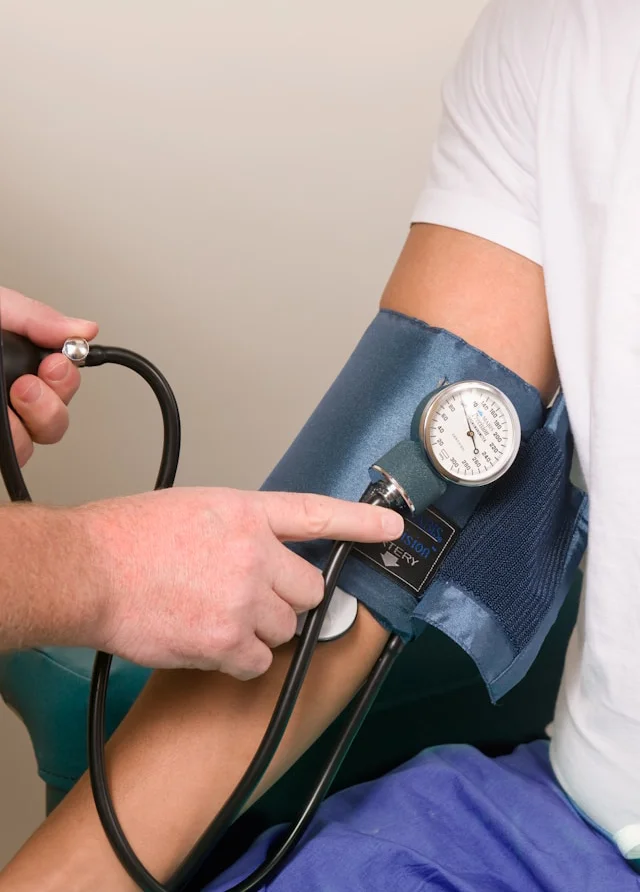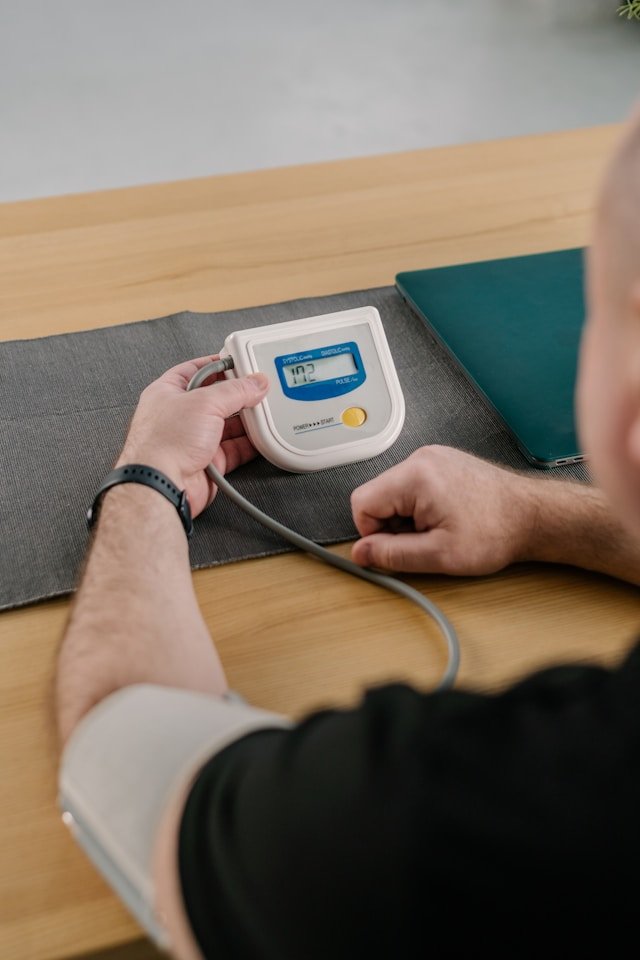DOT PHYSICAL
Understanding High Blood Pressure
Blood pressure readings can determine how long your DOT physical is good for. The FMCSA has laid out guidelines for blood pressure as it relates to DOT physical exams. Several factors contribute to high blood pressure, including genetics, age, weight, diet, lifestyle choices, and stress. Genetics play a role in high blood pressure, as it tends to run in families.
As people age, their blood vessels become less elastic, making it harder for blood to flow through them. Being overweight or obese also increases the risk of high blood pressure, as it puts extra strain on the heart. A diet high in sodium and low in potassium can also contribute to high blood pressure.
Finally, stress can cause a temporary increase in blood pressure, and chronic stress can lead to long-term high blood pressure.

Why Blood Pressure Matters

DOT Physical Certification Based on Blood Pressure Levels
The FMCSA has established certification periods for commercial drivers based on their blood pressure levels. Drivers with normal blood pressure are certified for a period of two years. Drivers with Stage 1 hypertension are certified for a period of one year. Drivers with Stage 2 hypertension are given a temporary certification for a period of three months, after which a follow-up examination is required. Drivers with Stage 3 hypertension are disqualified until their blood pressure is reduced to an acceptable level.
It is important for commercial drivers to maintain healthy blood pressure levels to ensure their safety on the road and to comply with DOT physical certification requirements.

Blood Pressure Standards for DOT Physicals
The Federal Motor Carrier Safety Administration (FMCSA) has set specific blood pressure standards for commercial drivers to ensure their safety on the road. Normal blood pressure is defined as systolic pressure below 140 mmHg and diastolic pressure below 90 mmHg. Stage 1 hypertension is defined as systolic pressure between 140-159 mmHg or diastolic pressure between 90-99 mmHg.
Stage 2 hypertension is defined as systolic pressure between 160-179 mmHg or diastolic pressure between 100-109 mmHg. Stage 3 hypertension is defined as systolic pressure above 180 mmHg or diastolic pressure above 110 mmHg.

Managing High Blood Pressure for Commercial Drivers
Lifestyle Changes
To manage high blood pressure, commercial drivers should make some lifestyle changes. A healthy diet is essential, including fruits, vegetables, whole grains, and lean proteins. Regular exercise for at least 150 minutes per week can also help. Maintaining a healthy weight is crucial to reduce strain on the heart. Stress management techniques like meditation, deep breathing, and yoga can help reduce stress levels.
Commercial drivers should also limit alcohol intake to no more than two drinks per day for men and one drink per day for women.
Medication Management
In some cases, lifestyle changes may not be enough to control high blood pressure. In these situations, healthcare providers may prescribe medication to help manage the condition. Commercial drivers should work closely with their healthcare providers to find the right medication regimen and monitor their blood pressure regularly.
It is crucial to follow the medication regimen as prescribed and report any side effects to the healthcare provider immediately. Commercial drivers should also notify their employers about their medication use and any side effects that may affect their ability to operate a vehicle safely.
Treatment Options for High Blood Pressure
If lifestyle modifications are not enough to control blood pressure, medication may be recommended. There are several classes of blood pressure medications, including diuretics, beta-blockers, calcium channel blockers, ACE inhibitors, and angiotensin II receptor blockers (ARBs).
Diuretics help the kidneys remove excess sodium and water, reducing blood volume and lowering blood pressure. Beta-blockers reduce the heart rate and workload, helping to lower blood pressure. Calcium channel blockers help relax blood vessel walls by blocking calcium from entering heart and blood vessel cells.
ACE inhibitors block the production of angiotensin II, a substance that narrows blood vessels, thus helping to lower blood pressure. ARBs block the action of angiotensin II, allowing blood vessels to widen and lower blood pressure.
A healthcare provider will work with the patient to find the most appropriate medication and dosage for their needs.

Monitoring Your Blood Pressure
Regular monitoring of blood pressure is essential for maintaining healthy levels and identifying potential issues early. Here are some tips for effective blood pressure monitoring:
- Invest in a reliable home blood pressure monitor: Choose a monitor that has been validated and approved by a recognized organization.
- Measure at the same time every day: Consistency is key. Measure blood pressure at the same time each day, ideally in the morning before taking medications and in the evening before bedtime.
- Follow proper technique: Sit with the back supported and feet flat on the floor. Rest the arm on a table with the upper arm at heart level. Relax for a few minutes before taking the measurement.
- Track the results: Keep a log of blood pressure readings and share this information with a healthcare provider during appointments.
By following these tips, individuals can effectively monitor their blood pressure and take necessary steps to maintain healthy levels.

Frequently Asked Questions
Can Drivers with High Blood Pressure Still Drive?
Drivers with high blood pressure can still drive as long as their blood pressure is under control and within acceptable guidelines. It is essential for drivers to work closely with their healthcare provider to manage their blood pressure and ensure it meets the requirements for a DOT physical exam.
How Often Should Drivers Have Their Blood Pressure Checked?
Commercial drivers should have their blood pressure checked during their DOT physical examination, which is required every two years. However, drivers with a history of high blood pressure may need to check it more frequently as recommended by their healthcare provider.
What Should Drivers Do if Their Blood Pressure is Too High During Their DOT Physical?
If drivers’ blood pressure is too high during their DOT exam, they may be granted a temporary medical certification while they work with their healthcare provider to lower their blood pressure. This may include lifestyle modifications, medication adjustments, or additional treatment options.
It is crucial for drivers to manage their high blood pressure for their safety and well-being. Following the tips and recommendations outlined in this guide can help drivers maintain healthy blood pressure levels and ensure a successful DOT physical examination.
Drivers may call the DOT physical exam testing center near them at 704-541-7111 for more information.
Can high blood pressure cause a driver to fail a DOT physical in Charlotte?
Yes, high blood pressure can cause a driver to fail a DOT physical in Charlotte. The Federal Motor Carrier Safety Administration (FMCSA) requires drivers to have a blood pressure reading of less than 140/90 mmHg to pass the physical exam. If a driver’s blood pressure is higher than this, they may be required to seek medical treatment and bring their blood pressure under control before they can pass the exam.
What are the requirements for passing a DOT physical in Charlotte?
To pass a DOT physical in Charlotte, drivers must meet certain requirements set by the FMCSA. These requirements include having a blood pressure reading of less than 140/90 mmHg, a pulse rate between 60-100 beats per minute, and a clear vision in both eyes. Drivers must also pass a hearing test, have a healthy respiratory system, and not have any medical conditions that could interfere with their ability to safely operate a commercial motor vehicle.
What should a driver expect during a DOT physical in Charlotte?
During a DOT physical in Charlotte, a driver can expect to undergo a thorough medical examination that includes a review of their medical history, a physical examination, and various tests to assess their overall health and fitness to drive. The exam may include a vision and hearing test, a blood pressure check, a urine test, and a check of the driver’s heart, lungs, and other vital organs.
How can a driver prepare for their DOT physical in Charlotte?
To prepare for their DOT physical in Charlotte, drivers should review the FMCSA’s medical requirements and ensure that they are in good health and meet all of the necessary criteria. Drivers should also bring any necessary medical records and medications with them to the exam, and be prepared to answer questions about their medical history and any current health conditions.
Are there any restrictions for drivers with high blood pressure in Charlotte?
Yes, drivers with high blood pressure in Charlotte may face certain restrictions on their commercial driving privileges. The FMCSA requires drivers with high blood pressure to have their condition under control and to provide proof of treatment before they can be certified to drive a commercial motor vehicle. Drivers with high blood pressure may also be required to undergo more frequent medical exams to ensure that their condition remains under control.
Is there a certain pulse rate required for passing a DOT physical in Charlotte?
Yes, there is a certain pulse rate required for passing a DOT physical in Charlotte. According to the FMCSA, drivers must have a pulse rate between 60-100 beats per minute to pass the exam. Drivers with a pulse rate outside of this range may be required to seek medical treatment and bring their pulse rate under control before they can pass the exam.
